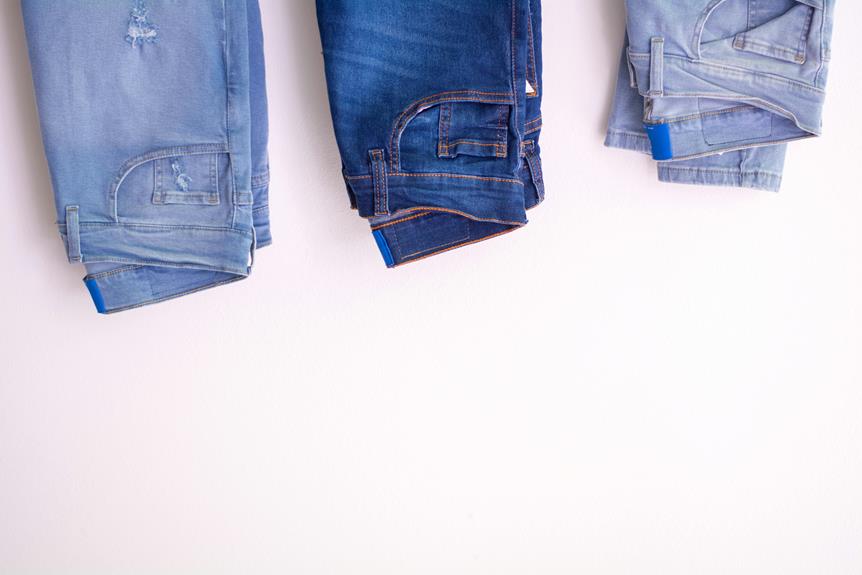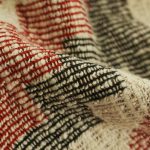When you wear clothing made from Poly Tricot fabric, you may notice that your skin feels hotter and more humid than usual. This isn't just a minor discomfort – it's a sign that the fabric is trapping moisture and heat, which can have serious consequences for your skin health. As you'll soon discover, Poly Tricot's synthetic fibers and tight weave can lead to a range of issues, from skin irritation and dryness to more serious conditions like eczema and acne. But what exactly is it about Poly Tricot that makes it so problematic for skin breathability, and what can you do about it?
Table of Contents
What Is Poly Tricot Fabric
Poly Tricot fabric differs from other types of fabrics due to its unique tricot weave, which creates a soft, smooth, and lightweight fabric perfect for garments that require flexibility and durability.
The tricot weave gives Poly Tricot fabric a distinct sheen, which not only provides a stylish appearance but also helps to repel water and wind. Additionally, the fabric's tight weave makes it resistant to wrinkles and shrinkage.
Poly Tricot fabric is a popular choice for activewear and outdoor gear due to its breathability and moisture-wicking properties, making it ideal for high-intensity activities. Its durability also ensures that it will withstand repeated wear and tear.
Poly Tricot fabric is suitable for various activities, including hiking, biking, or lounging around, making it a great choice for anyone who values comfort and performance.
Skin Breathability and Moisture
As you consider the impact of poly tricot on skin breathability, you'll want to think about how it affects your skin's natural moisture levels.
You'll also need to consider how poly tricot interacts with your skin's pH balance, which can influence its ability to breathe and regulate moisture.
Natural Moisture Levels
Your skin's natural moisture levels play a crucial role in maintaining its health and functionality, with the ability to breathe and regulate moisture being essential for its overall well-being.
When your skin's natural moisture levels are in balance, it can efficiently release excess moisture and retain the right amount to stay hydrated.
This balance is crucial for your skin's barrier function, which helps to prevent external irritants and allergens from penetrating the skin.
If your skin's natural moisture levels are disrupted, it can lead to discomfort, irritation, and even skin conditions like eczema or acne.
You may notice that your skin feels tight, dry, or oily, which can be a sign that its natural moisture balance is off.
Factors like humidity, temperature, and clothing can all impact your skin's natural moisture levels.
For example, if you wear tight or synthetic clothing, it can trap moisture and disrupt your skin's natural balance.
By understanding how your skin regulates moisture, you can take steps to maintain its natural balance and support its overall health.
This is especially important when it comes to choosing fabrics like poly tricot that come into contact with your skin.
Skin Ph Balance
Maintaining your skin's natural pH balance is crucial for optimal breathability and moisture regulation, and disruptions to this delicate balance can lead to skin irritation and discomfort.
Your skin's natural pH is slightly acidic, ranging from 4.5 to 5.5, which allows it to effectively regulate moisture levels and maintain its barrier function.
If your skin's pH balance is disrupted, you may experience irritation, itchiness, and redness. Disruptions can be caused by several factors.
- Using harsh skin care products can strip your skin of its natural oils, disrupting its pH balance. Products with high or low pH levels can have this effect.
- Exposure to environmental factors can alter your skin's pH levels. Pollution, wind, and extreme temperatures are all potential disruptors.
- Diet and lifestyle choices can also impact your skin's pH balance. A diet high in processed foods and sugar can lead to inflammation, which can disrupt your skin's pH balance.
It's essential to take steps to maintain your skin's natural pH balance, especially if you're prone to skin irritation or have sensitive skin.
Breathability and Hydration
Breathability and Hydration
When it comes to skin breathability and hydration, the ability of your skin to regulate moisture levels is crucial for optimal skin health. Your skin's natural barrier function helps to prevent water loss, while also allowing moisture to escape when necessary. This delicate balance is essential for maintaining healthy, supple skin.
| Breathability Factors | Hydration Effects |
|---|---|
| Natural Fiber Clothing | Allows for airflow and moisture wicking, keeping skin hydrated and comfortable |
| Synthetic Fiber Clothing (like Poly Tricot) | Traps heat and moisture, potentially leading to skin irritation and dryness |
| Environmental Conditions | Extreme temperatures and humidity levels can disrupt skin's natural moisture balance |
When wearing clothing made from Poly Tricot, you may notice that your skin feels hotter and more prone to sweating. This is because the synthetic fibers in Poly Tricot can trap heat and moisture, rather than allowing for airflow and moisture wicking. As a result, your skin may become dehydrated and irritated, leading to discomfort and potentially even skin problems. By understanding how Poly Tricot affects skin breathability and hydration, you can take steps to mitigate these effects and maintain healthy, happy skin.
Poly Tricot's Breathability Issues
When you wear clothing made of poly tricot, you may notice that it can feel hot and clammy against your skin, which is often a sign of poor breathability. This is because poly tricot is a synthetic fabric that can trap heat and moisture, making you feel uncomfortable and sweaty.
- Trapped moisture: Poly tricot's synthetic fibers can't absorb moisture like natural fibers can, so sweat gets trapped between the fabric and your skin, making you feel clammy.
- Heat buildup: Poly tricot can retain heat, making you feel warmer than you'd in clothing made of breathable fabrics.
- Lack of airflow: Poly tricot's dense weave can prevent airflow, which means that heat and moisture can't escape easily.
Effects on Skin Health
When you wear poly tricot clothing, you're likely to experience some negative effects on your skin health.
You'll want to consider the risk of skin irritation, as poly tricot's limited breathability can trap sweat and bacteria next to your skin.
Skin Irritation Risk
You may be wondering how poly tricot fabrics can affect your skin health, and it's essential to consider the risk of skin irritation when wearing clothing made from this material. While poly tricot is generally considered a safe fabric, it's not entirely free from potential skin irritation risks.
* Chemical sensitivity: Poly tricot is often treated with chemicals like dyes, finishes, or softeners that can cause skin irritation in some people. If you have sensitive skin, you may react to these chemicals.
* Friction and rubbing: Poly tricot can sometimes cause friction and rubbing, especially if the fabric is rough or poorly fitted. This can lead to skin irritation, especially in areas with delicate skin.
* Moisture buildup: Poly tricot's moisture-wicking properties can sometimes backfire, trapping sweat and moisture close to your skin. This can create a humid environment that fosters bacterial growth, potentially leading to skin irritation.
* Individual skin conditions: If you have pre-existing skin conditions like eczema, psoriasis, or acne, poly tricot fabrics may exacerbate your symptoms or cause irritation.
Remember that individual tolerance to poly tricot fabrics can vary greatly.
Moisture Retention Levels
Considering the potential skin irritation risks associated with poly tricot fabrics, it's worth examining how their moisture retention levels can impact your skin health. When you wear poly tricot clothing, it can trap moisture close to your skin, which can lead to discomfort and skin issues. If you're active or live in a humid climate, this can be especially problematic, as the trapped moisture can create a breeding ground for bacteria and fungi.
As a result, you may experience skin redness, itchiness, or eczema-like symptoms. Moreover, if you have pre-existing skin conditions like acne or eczema, the moisture retention levels of poly tricot fabrics can exacerbate your symptoms.
It's essential to be aware of these potential effects and take steps to mitigate them, such as wearing breathable undergarments or choosing poly tricot clothing with moisture-wicking treatments. By understanding how poly tricot fabrics affect your skin health, you can make informed choices to minimize potential risks and stay comfortable. By taking these precautions, you can enjoy the benefits of poly tricot clothing while protecting your skin.
Allergic Reaction Rates
Poly tricot fabrics have been linked to higher allergic reaction rates compared to natural fibers, with some studies suggesting that up to 10% of people may experience an adverse skin response after wearing poly tricot clothing. If you're someone who's prone to skin allergies, you might want to think twice before donning poly tricot garments.
- Skin irritation: Redness, itching, and rashes can occur due to the fabric's synthetic fibers.
- Contact dermatitis: Poly tricot can cause an allergic reaction, leading to inflammation and skin lesions.
- Eczema exacerbation: If you already have eczema, wearing poly tricot clothing can make your symptoms worse.
If you experience any of these symptoms after wearing poly tricot clothing, it's best to remove the garment and switch to natural fibers like cotton or silk.
Alternatives to Poly Tricot
Several alternatives to poly tricot have emerged in recent years, offering improved skin breathability and performance in various applications. You may be considering switching to one of these alternatives, especially if you've experienced skin irritation or discomfort with poly tricot.
One popular option is polyester mesh, which provides excellent airflow and moisture-wicking properties. Another alternative is nylon mesh, which is known for its lightweight and breathable design. You may also consider cotton or bamboo fabrics, which are natural, breathable, and gentle on the skin.
When evaluating these alternatives, you should consider the specific requirements of your application. For example, if you need a fabric that can withstand high temperatures or heavy use, polyester or nylon mesh may be a better choice.
On the other hand, if you prioritize natural fibers and softness, cotton or bamboo may be the way to go. By exploring these alternatives, you can find a fabric that balances performance and skin breathability, ensuring a more comfortable and healthy experience for your skin.
Choosing Breathable Fabrics
When selecting a breathable fabric, you'll want to look for materials that allow for airflow and moisture transfer, as these properties can significantly impact your skin's comfort and health. Breathable fabrics can help regulate body temperature, prevent moisture buildup, and reduce the risk of skin irritation.
To choose the right breathable fabric for your needs, consider the following factors:
- Natural fibers: Opt for natural fibers like cotton, linen, and bamboo, which are known for their breathability and moisture-wicking properties.
- Moisture-wicking treatments: Look for fabrics with moisture-wicking treatments that can help draw sweat away from the skin and evaporate it quickly.
- Open weaves: Fabrics with open weaves or loose constructions can provide better airflow and breathability than tightly woven fabrics.
Frequently Asked Questions
Can Poly Tricot Fabric Cause Skin Irritation in Sensitive Individuals?
If you're a sensitive person, be cautious, poly tricot can potentially irritate your skin due to its synthetic fibers. Wear breathable tops under your outfit to prevent this irritation or switch to cotton clothes altogether.
How Does Poly Tricot Compare to Cotton in Terms of Breathability?
You're comparing poly tricot to cotton in terms of breathability. Poly tricot is a synthetic fabric that can trap heat and moisture, whereas cotton is a natural fiber that allows for airflow and moisture wicking.
Is Poly Tricot Fabric Suitable for Athletic Wear and Activewear?
When choosing athletic wear, you're probably looking for fabrics that wick moisture and dry fast. Poly tricot fabric is a good option, as it's lightweight, quick-drying, and doesn't cling to your skin during intense workouts.
Can Poly Tricot Fabric Be Treated to Improve Its Breathability?
You can enhance poly tricot's breathability with treatments like moisture-wicking coatings or integrating mesh panels, which improve airflow and sweat evaporation. Additionally, blending it with natural fibers can also increase its breathability.
Does Poly Tricot Fabric Retain Body Odor and Sweat?
You might've noticed how some fabrics seem to trap sweat and odor. Poly tricot's synthetic fibers can make it prone to retaining body odor and sweat, especially when you're active or in warm weather conditions.
- How Does Ring Spun Cotton Affect Garment Fit and Shape Retention? - August 13, 2024
- What Are the Challenges in Producing Ring Spun Cotton? - August 13, 2024
- Is Ring Spun Cotton Suitable for Plus-Size Clothing? - August 13, 2024







